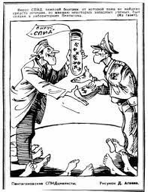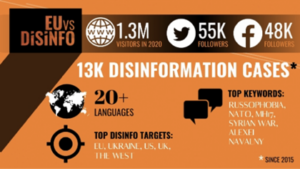by Todd Leventhal
An intriguing and important question for students of disinformation and propaganda is: how do Soviet and post-Soviet Russian disinformation and propaganda differ, why, and what does this indicate for the future?
I believe an unbiased analysis reveals that:
- there is a great deal of continuity between the goals and techniques of Soviet and post-Soviet Russian disinformation and propaganda.
- the new digital media environment offers unprecedented ways for new Russian disinformation and propaganda instruments, including RT (formerly Russia Today) and Sputnik, to influence foreign audiences.
- the reelection of Donald Trump would offer unparalleled opportunities for Soviet influence on US international policy at the very highest level.
Continuity of Goals
It is unlikely that the overall goals of current-day Russian disinformation have changed significantly from the Soviet era. According to KGB Lexicon: The Soviet Intelligence Officer’s Handbook, an authoritative dictionary of Soviet intelligence terms edited by former KGB foreign intelligence chief archivist Vasili Mitrokhin, the goals of Soviet active measures (the KGB term for covert influence operations, including disinformation) were to: 1) “exert influence on the adversary” and 2) “weaken his political, economic, scientific, and technical and military positions.” (p. 111)
There is little reason to believe that today’s Kremlin leaders, with their KGB backgrounds, have not instructed Russia’s intelligence services to pursue the same broad and, from the Kremlin’s point of view, presumably uncontroversial, goals.
Increasing Sophistication in Disinformation Techniques
The November 7, 2023 US State Department Media Note titled “The Kremlin’s Efforts to Covertly Spread Disinformation in Latin America” says, inter alia:
The Russian government is currently financing an on-going, well-funded disinformation campaign across Latin America. The Kremlin’s campaign plans to leverage developed media contacts in Argentina, Bolivia, Chile, Colombia, Cuba, Mexico, Venezuela, Brazil, Ecuador, Panama, Paraguay, Peru, and Uruguay, among other countries in Latin America, in order to carry out an information manipulation campaign …. The Kremlin’s ultimate goal appears to be to launder its propaganda and disinformation through local media in a way that feels organic to Latin American audiences to undermine support for Ukraine and propagate anti-U.S. and anti-NATO sentiment.
… Moscow seeds original stories or amplifies preexisting popular or divisive discourse using a network of state media [presumably primarily RT, Sputnik, and TASS], proxy, and social media influence actors and then intensifies that content to further penetrate the Western information environment. These activities can include disseminating false content and amplifying information perceived as beneficial to Russian influence efforts or conspiracy theories.
The Media Note describes how this process works. It says:
- A cultivated group of editorial staff would be organized in a Latin American country, most likely in Chile, with several local individuals and representatives – journalists and public opinion leaders – of various countries in the region.
- A team in Russia would then create content and send the material to the editorial staff in Latin America for review, editing, and ultimately publication in local mass media. In effect, this information laundering process would see pro-Kremlin content created in Russia get localized by the … Latin American staff and published in Latin American media to appear organic.
The Media Note adds:
- There are coordinated efforts between Russian embassies in Latin America and state-funded media outlets to increase pro-Kremlin messaging, spread anti-U.S. narratives, and develop partnerships among Russian state media, local media outlets and radio stations, perceived pro-Moscow third-country embassies in the region, and local journalists.
This is an extensive, very impressive, highly professional disinformation effort. It builds on methods the KGB pioneered but adds layers of sophistication and penetration of adversary media environments that did not exist in Soviet times.
Earlier, Less-Sophisticated Soviet Disinformation Practices
Current Russian efforts follow the basic approach the USSR took in its disinformation and covert influence operations, which have been described by Ladislav Bittman, who served from 1964 to 1966 as deputy chief of the Czechoslovak foreign intelligence service’s special operations department, which was responsible for disinformation and covert influence operations and worked closely with the KGB. Bittman defected to the United States in 1968. Four years later, in his book about disinformation operations, The Deception Game, he wrote:
Our main objective was to note and dissect all the enemy’s weaknesses and sensitive or vulnerable spots and to analyze his failures and mistakes in order to exploit them. The formulation of special operations might remind one of a doctor who, in treating the patient entrusted to his care, prolongs his illness and speeds him to an early grave instead of curing him. (The Deception Game, p. 124)
Just before the Reagan-Gorbachev summit at Geneva in 1985, a reporter for United Press International asked Bittman how he would construct a disinformation campaign if the summit failed to reach an agreement. He told the reporter:
If I were still in the business, I would carefully analyze the American and European press, particularly any comments about President Reagan’s unwillingness to cooperate, or about splits within the administration.
I would compose a series of phony messages, including some verifiable, true information, and add a few dramatic statements “proving” that the U.S. president came to the summit with a plan that it should not succeed.
I would start it in the European press, using two or three journalists with respected names, who would write stories that would fit their previous bias. The journalists would do some of their own research and background and so they would be able to say, quite properly, that they did their own reporting. It would be written in their own style.
An archetypal Soviet disinformation campaign was the AIDS disinformation campaign of the 1980s, which falsely accused the US government of creating the virus that causes AIDS. This false story first appeared in the Patriot, an English-language newspaper in India known to be controlled by the KGB, as attested by various KGB defectors. The Soviet press then repeated the disinformation and from there the Soviet press agency Novosti spread it around the world overtly, while KGB officers covertly planted the story in the media of various countries.

As shown in the November 7 Media Note described above, Russia uses the same manipulative methods today, 55 years after Bittman defected. But the Note also shows how the methods have developed and deepened, as indicated by the degree to which people and entities in other countries are involved in crafting modern-day Russian disinformation.
Abandoning Communism and Elevating Chekism
When the USSR abandoned communist ideology in its dying days, it freed the hands of Russian propagandists and disinformation professionals, enabling them to become much more ecumenical in devising propaganda and disinformation themes.
The fact that post-Soviet Russia has been ruled for more than two decades by a former KGB officer also presumably gave Chekist (Russian security and intelligence service) methods, including disinformation, greater cachet in the Kremlin. (Cheka is a contraction of the name of the first Bolshevik security and intelligence service, founded by Lenin in December 1917.) The Putin regime can be accurately described as a post-Soviet mafia/Chekist state, as the boundaries between the Russian state and criminal enterprises have become porous.
The Impact of Digital Media
The advent of digital media, the Internet, and social media have meant that the Kremlin now has many more ways to influence foreign audiences with disinformation and propaganda. In the Soviet era, the main way the KGB tried to influence foreign audiences using disinformation was by creating forgeries, often composed of fake US government documents, or the documents of other countries. In The Deception Game, Ladislav Bittman described the elaborate efforts needed to “surface” a forgery – to get it to the attention of the foreign press in a country that they are trying to influence, so that it could have an effect. Many times, it would be mailed to a journalist with an unsigned note saying, “This might interest you,” or words to that effect. There was no sure way to guarantee that the journalist would publish it, and weeks or months of effort invested in composing a genuine-looking forgery often went to waste.
In today’s digital world, however, Russia can easily “plant” fake items in social media by inventing a phony social media persona – or hundreds of them. So, their job is much, much easier.

Compare Soviet attempts to influence the U.S. presidential election of 1984, in which Ronald Reagan ran for reelection, with Russian interference in the 2016 U.S. presidential election, in which Donald Trump was elected.
In 1983, the KGB came up with the slogan “Reagan Means War” to try to defeat Reagan and ordered the KGB to spread this slogan in 1984. This campaign had no discernible effect, and we probably would not have known about it if Vasili Mitrokhin, the former archivist for KGB foreign intelligence, had not defected in 1992 and revealed it.
Now, of course, the Russians can easily have different phony social media personas repeat any slogan or false claim they wish and work to make it go viral by trying to make it appear popular to the algorithms that social media companies use. So, we are in a new world in which Russian disinformation professionals have unprecedented access to media conversations in the West and other countries.
It is also much easier for modern Russian intelligence agencies to assess foreign attitudes and ways to influence foreign audiences, as ubiquitous digital media makes many countries an “open book.”
Vulnerability of Audiences
An important consideration regarding the effectiveness of hostile disinformation and propaganda is the vulnerability of the target audiences to various themes. In this respect, American audiences today appear to be much more vulnerable to Russian disinformation and propaganda themes than during the Cold War. Russia is no longer communist and atheistic, which made it anathema earlier. Instead, some American traditionalists now see much in common with Putin’s supposedly traditional values. And many Americans have been disillusioned by failed overseas wars. In such an environment, Kremlin propaganda and disinformation can have a much more devasting effect.
Russian President Vladimir Putin has signaled that criticism of Western powers as supposed neocolonialists will be a major theme in Russian propaganda. Putin mentioned the theme of “colonialism” repeatedly in his speech at the Valdai conference in October 2023. It makes sense for the Kremlin to emphasize a propaganda policy that is likely to resonate with many countries in the “global South” in the wake of increased European resistance to Russian blandishments following its brutal, unprovoked full-scale invasion of Ukraine in 2022, which dispelled many Western illusions about Kremlin intentions and behavior.
At the same time, young audiences in the United States are likely much more receptive to charges of Western colonialism than they were in past decades. A thoughtful article by Roger Cohen in the December 10, 2023, issue of The New York Times describes this transformation in public opinion. Cohen writes, “As an insult, or line of attack, ‘colonial’ is enjoying a field day.” Cohen continues:
One reason that “colonialism” has re-emerged as a withering accusation appears to lie in a fundamental reframing of world affairs. The view of history as an East-West conflict is losing ground to a view of it as a North-South battle. The West’s march of freedom from the French and American revolutions is colliding with a different historical perspective more focused on the millions of lives lost to the slave trade and the genocide of the native American peoples. …
… For the Global South, … the pre-eminent narrative of the past five centuries has been the North-South fight against colonialism in Africa, Asia and Latin America.
In such a public opinion environment, Russian charges of colonialism can be powerful, as Lavrov’s claim in November 2023 that “We are witnessing neo-colonial instincts in the West. There is a desire to continue living at the expense of others, as they have been doing for over 500 years.” He announced that a “Forum of the Opponents of Modern Neo-Colonial Practices will discuss concrete goals for democratizing the global economic order,” hosted by the United Russia party in early 2024.
Of course, such criticisms ignore the imperial roots of Russia, which stretch back centuries, as well as what seems like a classic imperialist war in Ukraine, as the Kremlin seeks to reestablish control over a former imperial possession. But people in the Global South were colonized by Western powers, not Russia, which was expanding instead in Central Asia, the Caucasus, and Eastern Europe, as Poland, Finland, and the Baltic states were incorporated into the Russian Empire in the 19th century.
Trump: A Presidential Candidate Likely to be a Uniquely Vulnerable Target for Russian Disinformation Efforts
The most important Soviet and Russian disinformation efforts have been and remain today aimed directly at leaders of other countries. In the past, such clandestine Soviet disinformation frequently focused on fears motivating foreign leaders, as discussed in the State Department Global Engagement Center’s Counter-Disinformation Dispatch #9: Clandestine Disinformation and Agents of Influence.
Chekists are flexible and adjust their influence techniques based on the vulnerabilities of their target audience. In this regard, former (and perhaps future) President Trump, is a uniquely vulnerable and important target for Russian disinformation, including on the very important subject of NATO.
It would have been unimaginable before the Trump era for a US president to suggest that he would like the United States to leave NATO. But, The New York Times reported in January 2019, “Senior administration officials told The New York Times that several times over the course of 2018, Mr. Trump privately said he wanted to withdraw from the North Atlantic Treaty Organization. …”
Politico reported in early 2024 that Trump made his anti-NATO views known to European policymakers:
One of Europe’s most senior politicians recounted how former US President Donald Trump privately warned that America would not come to the EU’s aid if it was attacked militarily.
“You need to understand that if Europe is under attack we will never come to help you and to support you,” Trump told European Commission President Ursula von der Leyen in 2020, according to French European Commissioner Thierry Breton, who was also present at a meeting at the World Economic Forum in Davos.
“By the way, NATO is dead, and we will leave, we will quit NATO,” Trump also said, according to Breton.
Trump’s top national security officials were reportedly able to persuade him not to pursue what would have been a disastrous course of action, but Trump has talked about withdrawing from NATO if he is elected again. His campaign website ominously says:
…we have to finish the process we began under my Administration of fundamentally reevaluating NATO’s purpose and NATO’s mission.
Because of concerns that a second Trump administration would withdraw from NATO, Congress, in December 2023, passed legislation barring any president from withdrawing from NATO without the concurrence of two-thirds of the Senate or separate Congressional legislation. But Trump has made it clear that in a crisis Europe would not be able to count on a United States led by him.
The destruction of NATO has been a Soviet and Russian goal for decades. Ladislav Bittman reports in The Deception Game that in the mid-1960s one of the primary goals of the Czechoslovak disinformation plan, developed in coordination with Soviet advisors, was that “the partnership of NATO countries would be weakened to the extent that the Atlantic alliance would not be renewed in 1969.” (p. 86).
A veteran Chekist such as Vladimir Putin is unlikely to neglect opportunities for influence that his private conversations with President Trump have presented or may present in the future, particularly on a subject as central to Russian security interests as the future of NATO. In this connection, it is particularly worrisome that, as president, Trump reportedly has kept the substance of his private discussions with Putin secret from his most senior national security officials, taking the notes of these private meetings from his interpreter and instructing him not to discuss what was said with anyone else.
Conclusions
In short, post-Soviet, Russian disinformation, with a Chekist in power in the Kremlin, is a much more serious problem than in Soviet times due to:
- The increased access Russia now has to audiences around the world.
- The extreme “democratization” of the digital media, which opens many avenues for Russian overt and covert influence.
- The increased sophistication of post-Soviet Russian covert media operations.
- The receptiveness to covert influence operations that a Chekist in the Kremlin presumably has.
- The greatly increased receptivity among Western audiences to anti-Western messages.
All this is occurring at a moment when the West is scrambling, not always with success, to try to reconstruct some of the robust capability it had in the 1980s to expose and counter Soviet disinformation. This capability was abandoned prematurely as soon as the USSR collapsed, as it was thought, naively, that the problem had disappeared, never to return – a classic, overly optimistic American mistake. Moreover, the opportunities for successful Russian influence operations are likely to expand to an unprecedented degree if there is a second Trump presidency.![]()
 Todd Leventhal has some 25 years of experience in countering Russian, Soviet, Iraqi, and other disinformation, conspiracy theories, and false stories, mainly for the U.S. Information Agency and the U.S. Department of State, starting in 1987. He wrote two USIA reports to Congress on Soviet disinformation, in 1988 and 1992, and 14 short Counter-Disinformation Dispatches on disinformation and how to counter it for State’s Global Engagement Center from 2020 to 2022. He is retired.
Todd Leventhal has some 25 years of experience in countering Russian, Soviet, Iraqi, and other disinformation, conspiracy theories, and false stories, mainly for the U.S. Information Agency and the U.S. Department of State, starting in 1987. He wrote two USIA reports to Congress on Soviet disinformation, in 1988 and 1992, and 14 short Counter-Disinformation Dispatches on disinformation and how to counter it for State’s Global Engagement Center from 2020 to 2022. He is retired.
